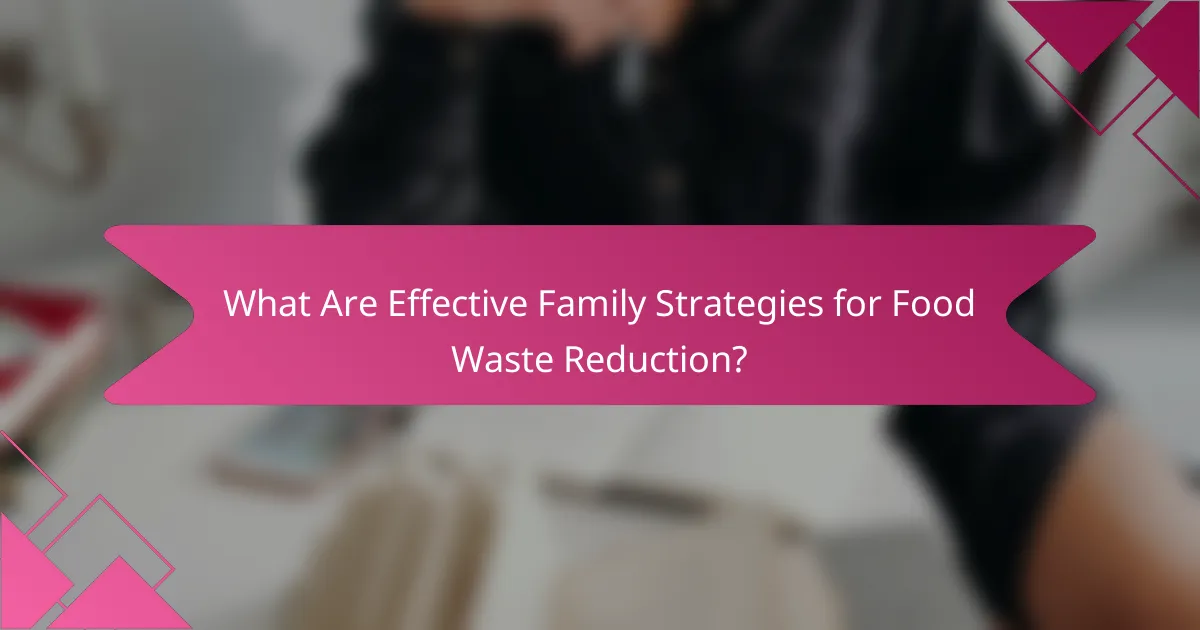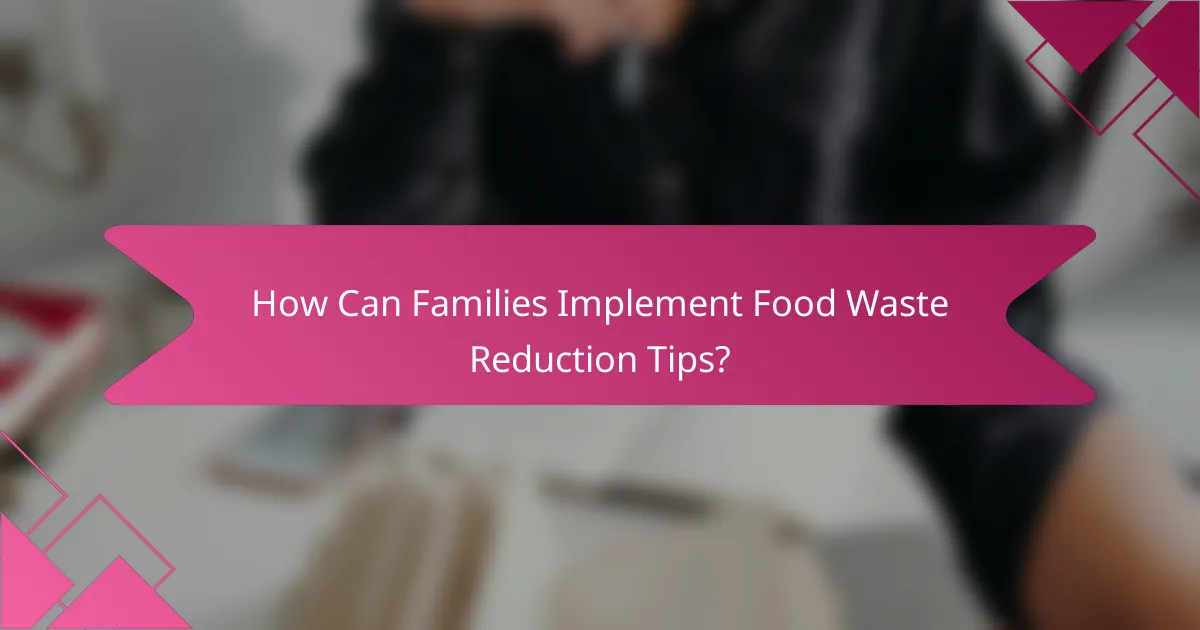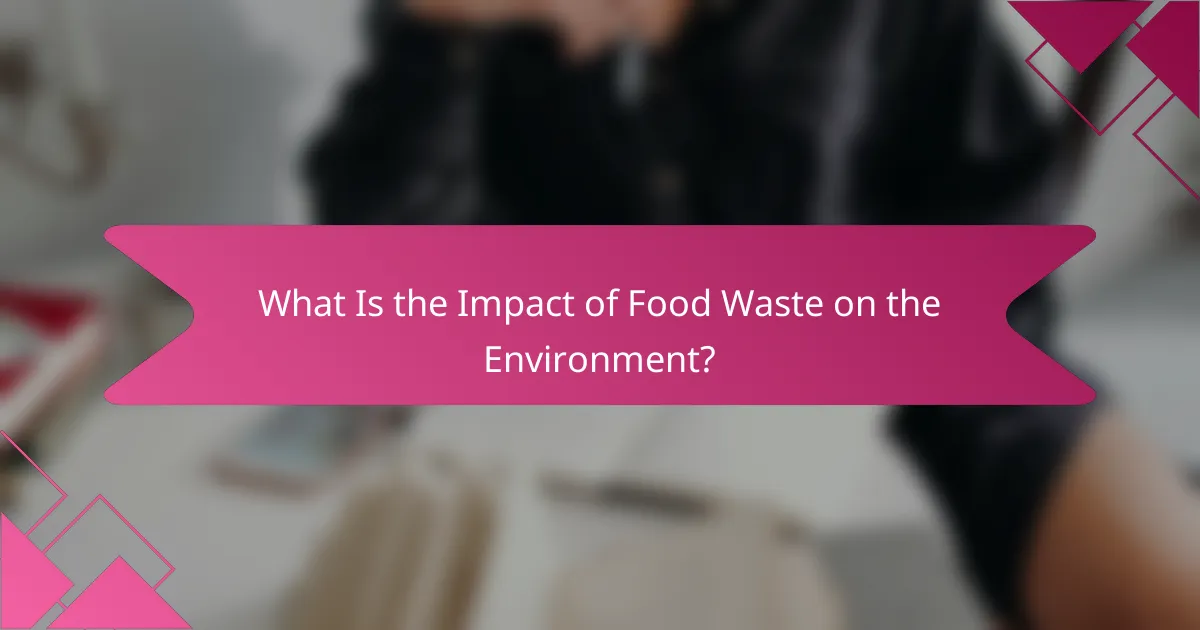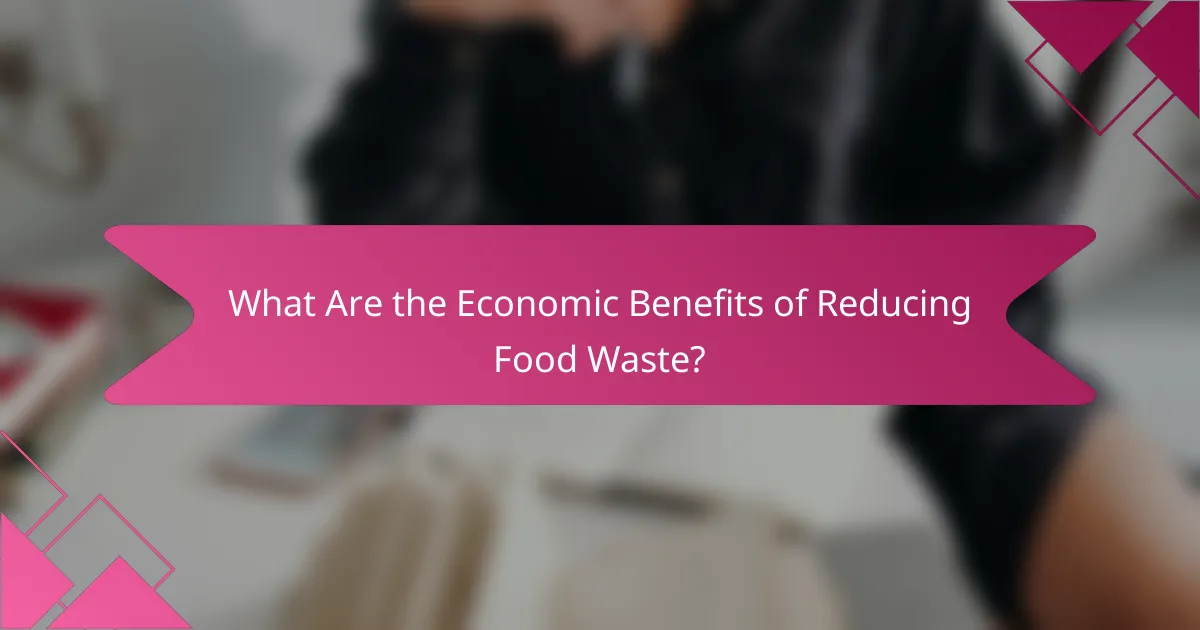Reducing food waste is essential for families looking to save money and protect the environment. By adopting effective strategies such as mindful shopping, proper food storage, and utilizing leftovers, families can significantly minimize waste. These practices not only conserve valuable resources but also contribute to a more sustainable future.

What Are Effective Family Strategies for Food Waste Reduction?
Effective family strategies for food waste reduction focus on planning, storing, and utilizing food efficiently. By implementing these approaches, families can significantly minimize waste while saving money and resources.
Meal planning
Meal planning involves organizing meals for the week to ensure that all purchased ingredients are used efficiently. Families can create a weekly menu that incorporates ingredients across multiple meals, reducing the likelihood of spoilage. Aim to plan meals that utilize similar ingredients to maximize usage.
Consider creating a shopping list based on your meal plan to avoid impulse purchases and ensure you only buy what you need. This can help keep your grocery bill in check while minimizing food waste.
Proper food storage
Proper food storage is crucial for extending the shelf life of perishable items. Use airtight containers for leftovers and ensure that your refrigerator is set to the right temperature, typically around 4°C (39°F). This helps slow down spoilage and keeps food fresher for longer.
Label containers with dates to track freshness and prioritize consumption. Organize your pantry and fridge so that older items are at the front, making them easier to access and use before newer purchases.
Portion control
Portion control helps prevent preparing more food than necessary, which can lead to waste. Serve smaller portions initially, allowing family members to request seconds if they are still hungry. This approach not only reduces waste but also encourages mindful eating.
When dining out, consider sharing dishes or taking leftovers home to avoid wasting food. Many restaurants offer takeout containers for uneaten meals, which can be a great way to enjoy your meal later.
Using leftovers creatively
Using leftovers creatively can transform potential waste into delicious new meals. Incorporate leftover vegetables into soups, stews, or stir-fries, and use stale bread for croutons or breadcrumbs. This not only reduces waste but also adds variety to your meals.
Consider dedicating one night a week to “leftover night,” where you creatively use up what’s in the fridge. This can be a fun family activity that encourages everyone to participate in meal creation.
Involving children in cooking
Involving children in cooking can foster a sense of responsibility and awareness about food waste. Teach them about ingredients, meal preparation, and the importance of using food wisely. This hands-on experience can help them appreciate food more and reduce waste in the long run.
Encourage children to help with meal planning and grocery shopping, allowing them to choose healthy options. This engagement can lead to better eating habits and a commitment to reducing waste as they grow older.

How Can Families Implement Food Waste Reduction Tips?
Families can effectively reduce food waste by adopting practical strategies that focus on mindful shopping, understanding food storage, and utilizing excess food. Implementing these tips not only conserves resources but also saves money and minimizes environmental impact.
Creating a shopping list
Creating a shopping list is a fundamental step in reducing food waste. By planning meals and listing only the necessary items, families can avoid impulse purchases that often lead to excess food. Aim to shop with a clear idea of what meals you will prepare for the week.
Consider organizing your list by food categories, such as produce, dairy, and grains, to streamline your shopping experience. This approach helps ensure that you buy only what you need, reducing the likelihood of food spoilage at home.
Understanding expiration dates
Understanding expiration dates is crucial for managing food freshness and safety. Familiarize yourself with terms like “sell by,” “use by,” and “best before,” as they indicate different aspects of food quality. “Sell by” dates are for retailers, while “use by” dates indicate the last date for optimal quality.
To minimize waste, prioritize consuming items that are nearing their expiration dates. Regularly check your pantry and refrigerator to use older items first, and consider freezing foods that you cannot consume in time to extend their shelf life.
Composting food scraps
Composting food scraps is an excellent way to reduce waste while enriching your garden. Families can compost vegetable peels, fruit cores, and other organic materials, turning them into nutrient-rich soil. This process not only diverts waste from landfills but also promotes sustainable gardening practices.
To start composting, designate a bin or area in your yard for organic waste. Be mindful of what you add; avoid meat and dairy to prevent odors and pests. Regularly turning the compost helps accelerate decomposition and produces usable compost in a few months.
Donating excess food
Donating excess food is a meaningful way to reduce waste while helping those in need. Many local food banks and charities accept non-perishable items and fresh produce that families cannot consume. Check with local organizations to understand their donation guidelines and needs.
Before donating, ensure that the food is still safe to eat and within its expiration date. Consider organizing a community food drive to encourage others to participate in reducing food waste and supporting local families in need.

What Is the Impact of Food Waste on the Environment?
Food waste significantly harms the environment by contributing to greenhouse gas emissions, depleting vital resources, and filling landfills. Reducing food waste can mitigate these impacts and promote sustainability.
Greenhouse gas emissions
When food waste decomposes in landfills, it produces methane, a potent greenhouse gas that is many times more effective at trapping heat in the atmosphere than carbon dioxide. In fact, food waste is estimated to account for a substantial portion of global methane emissions, contributing to climate change.
To combat this, families can implement strategies such as composting organic waste, which not only reduces landfill contributions but also enriches soil. Simple actions like planning meals and using leftovers can significantly decrease the amount of food that ends up wasted.
Resource depletion
Food production requires extensive resources, including water, energy, and land. When food is wasted, all the resources used in its production are also wasted. For instance, it takes thousands of liters of water to produce just a few kilograms of certain foods, such as beef.
To minimize resource depletion, families should focus on purchasing only what they need and utilizing seasonal produce, which often requires fewer resources to grow. Additionally, educating children about food sources can foster a culture of appreciation and reduce waste.
Impact on landfills
Food waste is one of the largest components of municipal solid waste in landfills, taking up valuable space and leading to increased landfill management costs. As landfills fill up, communities face challenges in waste management and may need to invest in new landfill sites or waste processing facilities.
Families can help alleviate this issue by practicing mindful consumption, such as making shopping lists and avoiding impulse purchases. Participating in local food recovery programs can also divert surplus food from landfills and support those in need.

How Do Family Habits Influence Food Waste?
Family habits play a crucial role in determining the amount of food waste generated. By understanding these habits, families can adopt strategies to minimize waste and make more sustainable choices.
Eating out vs. cooking at home
Eating out often leads to higher food waste compared to cooking at home. When dining out, portion sizes can be larger than needed, resulting in leftovers that may not be consumed. In contrast, cooking at home allows families to control portions and utilize ingredients more efficiently.
To reduce waste when eating out, consider sharing dishes or ordering smaller portions. When cooking at home, plan meals based on what ingredients you already have to avoid over-purchasing.
Shopping frequency
The frequency of grocery shopping significantly impacts food waste levels. Families that shop more frequently tend to buy only what they need, reducing the likelihood of spoilage. Conversely, those who shop less often may stock up on items that can go bad before they are used.
Establish a shopping routine that aligns with your meal planning. Aim for weekly trips to replenish fresh produce while using up items from your pantry to minimize waste.
Food preferences and trends
Food preferences and current trends can influence the types of food purchased and, consequently, the amount of waste generated. Families that follow popular diets may buy specialty items that they don’t fully utilize, leading to waste.
To combat this, focus on versatile ingredients that can be used in multiple meals. Additionally, consider seasonal produce, which is often fresher and less likely to spoil quickly, helping to reduce waste.

What Are the Economic Benefits of Reducing Food Waste?
Reducing food waste offers significant economic benefits, including lower grocery bills, decreased disposal costs, and enhanced food security. By minimizing waste, families can save money and contribute to a more sustainable food system.
Cost savings on groceries
One of the most immediate economic benefits of reducing food waste is the cost savings on groceries. Families can save anywhere from 20% to 30% on their grocery bills by planning meals, buying only what they need, and using leftovers creatively.
To maximize savings, consider creating a shopping list based on meal plans and sticking to it. Avoid impulse purchases and take advantage of sales on items that can be used before they spoil.
Reducing disposal fees
Reducing food waste can lead to lower disposal fees, as many municipalities charge for waste collection based on weight or volume. By minimizing the amount of food thrown away, families can decrease their waste output and, consequently, their disposal costs.
For instance, composting food scraps can also reduce the volume of waste sent to landfills, potentially lowering fees and benefiting the environment. Check local regulations regarding composting to ensure compliance and maximize benefits.
Increasing food security
Reducing food waste contributes to increased food security by ensuring that more food is available for those in need. When families waste less food, they can redirect savings to purchase more nutritious options or donate excess food to local food banks.
Participating in community initiatives that focus on food recovery can also enhance food security. Many organizations work to redistribute surplus food, helping to feed those who are food insecure while reducing overall waste.

What Tools and Apps Can Help Reduce Food Waste?
Several tools and apps are designed to help families minimize food waste by tracking inventory, suggesting recipes, and managing expiration dates. These resources can streamline meal planning and encourage better food management practices.
Inventory Management Apps
Inventory management apps allow users to keep track of food items in their pantry and refrigerator. By inputting items and their expiration dates, families can receive reminders about what needs to be used soon. Popular options include apps like NoWaste and Pantry Check, which help users avoid buying duplicates and ensure that food is consumed before it spoils.
Recipe Suggestion Tools
Recipe suggestion tools can help families utilize ingredients they already have, reducing the likelihood of waste. Apps such as SuperCook and Yummly allow users to input available ingredients and generate meal ideas based on what’s on hand. This not only saves money but also encourages creativity in the kitchen.
Food Donation Platforms
Food donation platforms connect individuals and families with local organizations that accept surplus food. Apps like OLIO and Food Rescue US facilitate the sharing of excess food with those in need, helping to reduce waste while supporting the community. Users can easily list available items and arrange for pickup or drop-off.
Expiration Date Trackers
Expiration date trackers help families monitor the freshness of their food items. Apps like Fridge Pal and Eat By Date provide notifications when items are nearing their expiration dates, prompting users to use them before they go bad. This proactive approach can significantly cut down on food waste at home.

